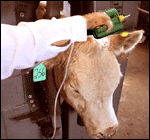The discovery of a dairy cow in Mabton, Wash., with bovine spongiform encephalopathy (BSE), or mad cow disease, has generated a great deal of interest in RFID for tracking cattle and other livestock in the United States. Dale A. Blasi, professor and beef specialist at Kansas State University, says RFID will eventually be used to track every domesticated animal from traditional livestock to the family pet. But it will take several years because a number of issues need to be resolved, including data privacy, the potential liability of those who raise the animals, and the cost and performance of RFID tags and readers.
The Canadian government tried to implement a bar code system to track cattle several years ago because RFID was deemed too costly for ranchers to implement. In addition, there were problems with bar codes. It took time and labor to scan each bar code, and the bar codes were often dirty or damaged, making it difficult or impossible to read them. On Sept. 22, the Canadian Cattle Identification Agency decided to scrap the bar code system and move to RFID beginning in January 2005.
The proposed U.S. Animal Identification Plan is based upon the use of ISO standard RFID technology to track cattle. Low-frequency transponders operate at 125 to 134.2 KHz and have a read range of less than three feet. Typically the cows are tracked as they move down a chute to and from a corral. Readers are set up on either side of the chute to read tags in the animals’ left ear. But the chutes are typically made of metal, which can interfere with the performance of the system.
“We have tested a lot of equipment from different vendors and have observed variable results,” says Blasi. “When you have animals lined up head to tail in a chute, there are some issues with getting the transponders to give up their numbers. Most commercial feeders [industrial beef producers] will have to make some design changes to their animal processing facilities so that the readers will work in their environment.”
Another major issue is cost to ranchers. The RFID transponders cost about $2.25 each. A hand-held wand reader is about $400, and then ranchers have to invest in computers and software. To help ranchers estimate the costs to buy, deploy, maintain and use cattle-tracking RFID hardware and related software and equipment, which can be significant, Blasi and Kevin Dhuyvetter, an economist at Kansas State University, created an interactive spreadsheet. (The spreadsheet can downloaded at www.beefstockerusa.org/rfid.)
“The average herd size in the U.S. is less than 40 head,” says Blasi. “Not everyone has the equipment to restrain the animal when the tag or transponder is applied in the left ear. Moreover, not everyone will require a reader for use day to day within their operations. There will likely be tagging facilities at auction markets to apply the transponder when a small farmer wants to sell an animal.”
It will take time for the infrastructure to be built to support RFID tracking. While the tags and readers have been around for a long time, there hasn’t been a lot of software designed specifically for certain segments of the cattle industry, such as stockers and backgrounders, which prepare young calves weaned from their mother for industrial feeding facilities. Blasi himself got involved with RFID while working with a colleague, Mark Spire, to develop software called Chuteside, which enables cattlemen to gather health and performance information about their herd.
“We realized that there was an incredible need for portable, actionable information,” he says. “The [mad cow disease] issue illuminates the need for trace-back. Our intent is to help producers document the healthcare records of all their animals, so they can transfer the data to a main computer and run reports and have hard statistics on all calves that come into their operation.”
Many cattle producers (ranchers, stockers and feeders) and value-added cooperatives or alliances are also concerned about the possibility of unscrupulous access and use of the data by their competition. The question of who has access to the data is an important one for many small producers who fear that the government and those opposed to the consumption of beef could use information in a way that would harm the industry.
A related question has to do with the liability of the producers. Today, retailers and packers bear the weight of litigation when a recall of beef occurs as a consequence of E. coli, listeria, salmonella or some other problem. Many producers are concerned that lawyers would be able to trace back further to the farm level and initiate legal action against the producer. Small family farmers are concerned that they would not a have the resources to defend themselves.
Despite the obstacles, Blasi believes that RFID is the only technology currently available that would enable the beef industry to meet the goal of being able to trace diseased animals within 48 hours. He’s confident that the issues impeding adoption will eventually be overcome. The cost of systems, for instance, may come down as Wal-Mart and others deploy RFID systems in their supply chain.
“Things are coming together,” says Blasi. “Wal-Mart is adopting RFID, and Wal-Mart happens to be the largest retailer of beef. It makes sense to integrate the food supply chain from end to end, and I think it will eventually happen. The challenge will be to make it a win-win situation for the producer and the consumer.”


